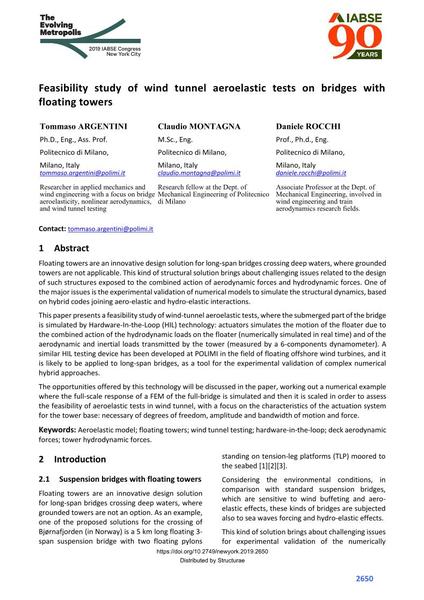Feasibility study of wind tunnel aeroelastic tests on bridges with floating towers

|
|
|||||||||||
Bibliografische Angaben
| Autor(en): |
Tommaso Argentini
Claudio Montagna (Politecnico di Milano) Daniele Rocchi (Politecnico di Milano) |
||||
|---|---|---|---|---|---|
| Medium: | Tagungsbeitrag | ||||
| Sprache(n): | Englisch | ||||
| Tagung: | IABSE Congress: The Evolving Metropolis, New York, NY, USA, 4-6 September 2019 | ||||
| Veröffentlicht in: | The Evolving Metropolis | ||||
|
|||||
| Seite(n): | 2650-2655 | ||||
| Anzahl der Seiten (im PDF): | 6 | ||||
| DOI: | 10.2749/newyork.2019.2650 | ||||
| Abstrakt: |
Floating towers are an innovative design solution for long-span bridges crossing deep waters, where grounded towers are not applicable. This kind of structural solution brings about challenging issues related to the design of such structures exposed to the combined action of aerodynamic forces and hydrodynamic forces. One of the major issues is the experimental validation of numerical models to simulate the structural dynamics, based on hybrid codes joining aero-elastic and hydro-elastic interactions. This paper presents a feasibility study of wind-tunnel aeroelastic tests, where the submerged part of the bridge is simulated by Hardware-In-the-Loop (HIL) technology: actuators simulates the motion of the floater due to the combined action of the hydrodynamic loads on the floater (numerically simulated in real time) and of the aerodynamic and inertial loads transmitted by the tower (measured by a 6-components dynamometer). A similar HIL testing device has been developed at POLIMI in the field of floating offshore wind turbines, and it is likely to be applied to long-span bridges, as a tool for the experimental validation of complex numerical hybrid approaches. The opportunities offered by this technology will be discussed in the paper, working out a numerical example where the full-scale response of a FEM of the full-bridge is simulated and then it is scaled in order to assess the feasibility of aeroelastic tests in wind tunnel, with a focus on the characteristics of the actuation system for the tower base: necessary of degrees of freedom, amplitude and bandwidth of motion and force. |
||||
